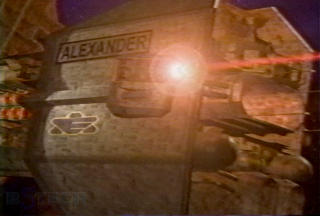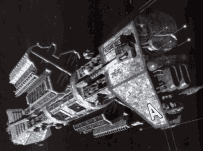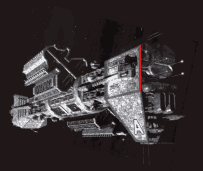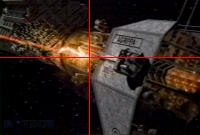![]()
|
||||
|
|
OMEGA CLASS
DESTROYER E.A.S.
Alexander Fires on the Roanoke In the season three episode "Severed Dreams", we saw Earth warships battling one another for control of Babylon 5, giving us the most accurate video information regarding the strengths and weaknesses of Humanity's weapons and defensive capabilities. In one scene, the Omega class Destroyer Alexander opens fire on the Destroyer Roanoke, (which the CGI team mistakenly labeled Agrippa, in one of the most embarrassing and infamous cock-ups of the B5 series). Now Alexander used her Particle lasers, giving us a very good idea of how powerful Earth weapons are and the damage done by their weapons, as we were able to see clearly what happened. Now, we will begin with some specifications. First of all, the gun ports on the Omega are between 15 and 16 meters in diameter, as proven in the image below. In the first image we see an image of the actual Omega mesh used on the TV series, taken from the "B5 Security Manual." While this image does not show us the front of the Omega strait on, it does give us an excellent means of estimating the barrel diameter. In the larger image (available via clicking the images above), we see the front of the Omega. Based on the ship's length of some 1,717 meters and the profile diagram shown in this document, we know that the center section of the Omega's armored cowl is approximately 126 meters in height. In image two we see that this area is 140 pixels in height. Divide 140 into 126 and we find that each pixel is 0.9 meters. The gun barrel seen on the hull is set back and away from the forward section of the hull, skewing our perspective but not by very much. Disregarding this however, the barrel comes out to be approximately 17 pixels in height. 17 multiplied by 0.9 and our figure comes out to be 15.3. Thus, depending on perspective, it is safe to say that the gun barrel of the Omega's forward particle laser is, as stated, between 15 and 16 meters in diameter. In all honesty it is probably closer to 16 meters, but for the sake of being conservative we will be using the lower figure of 15 meters. Hull and armor is believed to be 8 meters thick from the surface, to the inner wall of the Destroyer. Hull and armor thickness is based on two factors - the relative armor to hull thickness seen on modern Battleships, and the armor thickness we've seen on the Omega. Armor thickness is based on the cowl that covers the Omega's hangar sections surrounding the fighter launch tubes, sensors domes, missile launchers, hyperspace antenna array, forward jump engines, ram scoop, etc., etc., etc. The armored cowl is between three and five meters thick based on photo reference and comparison to the fighters. We'll use three and, assuming that the armor is at least as thick along the hull, this gives us a fair idea as to armor/hull thickness. Alexander opened fire with a raking blast that crossed some 320 meters of the hull's surface. Some dispute this, but as seen in the screen captures below, we can clearly see that the Alexander's beam first began cutting on the rotating Habitation section, NOT the Hangar section.
As seen in the images above, the Alexander's beam appears to strike somewhere aft of the rotating section, not the hub. Please take note of the running light just in front of where the beam makes initial contact. This clearly suggests that the beam struck aft of the rotational drivers, between the two running lights on the Omega's habitation area. The beam starts to cut into the Habitation section (notice there is now glow or reflection across the forward face of the rotating section upon initial impact), then rakes all the way across more than 3/4 of the Hangar section (note that a reflection from the glow now CAN be seen on the forward face of the rotating section, as it IS now in front of it and not under it). Given these figures and the schematic image seen above, it is clear that the Alexander's beam cut at least 320 meters across the Roanoke's hull. If the beam penetrated no deeper than the Omega's outer armor, some three meters thick, we now have enough information to safely estimate the volume brought to boil. Again we'll use the lower figure of 320. The beam cut into the hull of the Roanoke, leaving a white hot trail with peaks and valleys along the Destroyer's hull. The scene lasted only one second, where in which we saw the Roanoke's hull spark and glow white hot. There have been three theories regarding the effect of this blast. One states that the blast simply scorched the surface. Second states that it striped off some if not all the armor. Third states that it punched the hull and burned a gash across the whole of the Roanoke's hull, in and out. We will go with theory number two. This theory is supported by the fact that the beam clipped the hub where the gears are located for the Omega's rotating section. The beam cut into the hub, but rotation was neither lost nor visibly hindered, as clearly seen a few moments later when Sheridan open fire on the Roanoke and her rotating section was still turning. Also, since the hull was white hot, we can see that the weapon did more than just scorch the surface. We also saw no evidence of the beam punching all the way through the hull, which would have resulted in some form of explosive decompression, so we will assume that the beam merely boiled off the outer armor. Why boil and not vaporize? Because the beam left a white hot scar across the hull, and the sparking effects suggests that the beam did in fact do more damage than simply melting, but had it vaporized the armor then it would have also punched the hull causing explosive decompressions, which we did not see happen. Thus we can assert the following:
CONCLUSION - The total low-end output of what we assume to be a standard discharge from an Omega's primary forward particle laser cannon, comes to 1.79*1014 watts (179,842,016,448,000 watts - 179 Terawatts), or equal to a 43 kiloton bomb. As we know that the Omega's armor is NOT comprised of iron, and the general consensus is that the Earthforce armor is at least 20X stronger than our base matterial, the X-Ray/Particle laser on the Omega class Destroyer must have an average output of at least 3.59*1015 watt (3,596,840,328,960,000 watt - 3,596 Terawatt), or equal to an 860 kiloton bomb. Also, this is a standard discharge, not a maximum burst. Assuming that a standard discharge is 30% of critical power, the maximum output of the Omega's X-ray/Particle lasers would be 1.19*1016 watt (11,989,467,763,200,000 watt - 11,989 Terawatt), or equal to a 2.8 megaton bomb.
Math figures checked by Michael
Wong. |
|||||||||||||







